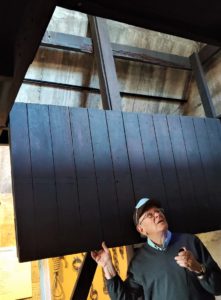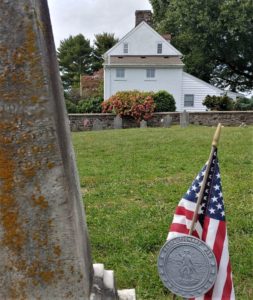Richboro handyman met his demise in 1892 on a gallows preserved in a Bucks museum.
There’s nothing quite like Doylestown’s Mercer Museum. Artifacts from Early America decorate the floors, walls and ceiling in the vast atrium of the 7-story monolith. Above you hang antique carriages, boats, wagons and a menagerie of implements from the 1800s conjuring up the glory, ardor and romanticism of a simpler time. Tucked into the top floor is history’s dark side: a gallows shared by Bucks and Northampton counties to hang convicted killers. I took a look recently at the apparatus that meted out justice before ticket-holding spectators in Doylestown. The heavy timber scaffold dominates the museum’s top floor. Visitors are directed to pass beneath its open trap door near windows overlooking the former county prison (now the Michener art museum) where the gallows was used.
One of the last to die in a hangman’s noose was Wallace Burt.

The story begins with Laura Slater who was delivering milk at dawn to her neighbor’s 44-acre farm on Middle Holland Road near Richboro. Laura had developed a friendship with farmer Samuel Rightly, 84, and wife Lena, 82, who lived in the farm’s two-story stone house, a former Lutheran mission adjoining Feaster Cemetery founded in 1748. With the house filling with smoke, Laura rushed inside and discovered the couple beaten to death in their bed. She ran from the premises to summon authorities who put out the fire and confirmed the couple’s deaths. Who did it? And why? Few clues turned up until investigators found a hunk of Big Chew tobacco on a fence near an open back window.
Suspects included a nephew and an itinerant farm worker. Both had alibis. A third suspect was a handyman last seen on the farm using a scythe to cut grass in the cemetery. Witnesses described Wallace Burt as mixed-race Cherokee, slender, 6 feet tall and 160 pounds. Police learned he tried to buy chewing tobacco at a Newtown store but didn’t have enough cash. He returned days later with a “wad of money”.
With a manhunt underway, a postal worker spotted Burt hiding in bushes in Yardley. Police arrested him. At the county prison in Doylestown, he confessed. He said he was hired by Sam Rightly for $1 (about $33 today) to cut grass in the cemetery using the farmer’s scythe. Afterward, Rightly paid him less for returning the scythe unsharpened. Burt, angered, knew the couple kept money in a small box under their bed having overheard an earlier conversation. Unable to buy chewing tobacco in Newtown, he said, he broke into the Rightly house at night, killed the couple with an axe as they slept, grabbed the money ($22) and set the house afire.

A county jury sentenced Burt to hang. At daybreak on July 26, 1894, he ate his last meal of ice cream, fish and eggs, then smoked a cigar. Just before 11 a.m., a dozen physicians assembled beside the scaffold on prison grounds. Guards led Burt from his cell wearing a dark blue business suit, white shirt and tie, his feet in manacles. Surveying spectators, he spotted an ex-sheriff and shouted derisively, “How are you? How’s your wife and children? I’ve been waiting to see you.”
Burt climbed the gallows stairs where he took position on a rope-operated trap door. The sheriff lowered a hood over the prisoner’s head, tightened the noose, then stepped from the platform. At exactly 11 a.m., Burt dropped into space and dangled nearly motionless. Thirteen minutes later his heart ceased beating.
Through the years, the Rightly home – called “the Murder House” in early parlance – remained a curiosity. A succession of owners resided there until Northampton condemned the farm for the new Council Rock High School South. Music teacher Tom Baust drove by a number of times. “The house had a certain allure,” he told a reporter. “I would slow down and wonder what stories this place could tell.” In 2001, he rented the home built in 1806. Four years later, he took possession at auction, completely remodeled it and began hosting an annual community festival featuring the history of the home, Baust’s many ornamental gardens and the cemetery where Revolutionary War soldiers are buried. He gave the home a new moniker: “the House of Many Waters” for its numerous fountains, a pond and babbling creek. Today the 3-acre property is owned by Michael and Christine Godshall who continue to enhance the magnificent house, landscaping and out buildings.
As for the gallows at the Mercer, the last time it was used was in 1914 when James Linzi who confessed to killing his pregnant wife perished on the scaffold. The presiding sheriff was Charles M. Meredith, a Quaker opposed to capital punishment. With spectators looking on, Meredith turned his back as the trap was sprung, ending the era of capital punishment in Bucks.
***
Sources include “Lovingly restored Northampton farmhouse to share its folklore” by Liz Johnson published in 2015 in the Bucks County Courier Times newspaper; “Ledger entry tells of 1894 hanging” by Lester Trauch in The Intelligencer newspaper published in 1978, and “Northampton, Then and Now” by Margo Levin published in Patch and located on the web at httpshttps://patch.com/pennsylvania/northampton/northampton-township-then-and-now-2

